
The deck and a half Commer Commandos (by Shane Conway)
Last updated 24 April 2024
`
SOME LINKS WITHIN THIS WEBSITE:
Home
Email
Links
THE COMPLETE WEBSITE MENU
Events Diary
Halfcab list
Small-Ads
Classic Irish Buses
Classic Manx Buses
THE DECK AND A HALF COMMER COMMANDOS
As regular readers of this site may be aware, Dick Gilbert was a keen fan of half cab single deck buses
of all descriptions and styles. Alongside that, most likely from spending his working life in the air industry, he also took an interest
in a batch of 315 Commer Commando buses built in the late 1940s which were originally intended to be used for getting passengers and
their luggage to and from airports and airfields. He has mentioned them on page 1 and
page 3 of the news and mail section, and on page 2 of the Australian
part of this website. He had hoped one day to compile a page or two on them, but never got round to doing it. So this page is an an
attempt to fulfil his wish.
A bit of background on them to begin with. The Commando was a mid sized chassis (about the size of a
Bedford OB) and was produced in both truck and bus formats. The model first appeared in 1939, and five buses were built before
hostilities halted production in 1940. It was 1946 before the sixth chassis was produced (number 17A0006), with a further 314 in a
consecutive series (up to 17A0320) following over the following two years. It is understood that the original order would have been for
375 buses, but the final 60 were cancelled. London based Park Royal Coachworks bodied all of them with a 20 seat coach body, with the
rear half of it raised to accomodate a large luggage compartment over the back axle. A further 328 chassis after these also received PSV
bodies, but to a more convential layout, and therefore are outside the scope of this page.
They were allocated to just four concerns, British Overseas Airways Corporation (BOAC), British European
Airways (BEA), Air Ministry and Ministry of Supply, but dispatched in a random order. BOAC took 115, of which 19 went to foreign
airports where their planes flew to, while BEA's batch of 44 were all solely based in the U.K, except for one based in Vienna, plus a
second one possibly in Berlin. The examples in mainland Europe were left hand drive layout. A further 64 were taken by the Ministry of
Supply, these in turn being issued to a variety of industrial facilities such as aircraft manufacturers and government departments,
while the Air Ministry took 92. While reg numbers are recorded for many of them, there are 84 for which the numbers are unknown. Below
is an attempt to list what information is known about them, mostly original delivery dates and identities, and the lists are in chassis
number order for each of the four concerns who took them. Away from the public gaze (mostly) these little buses quietly faded away during
the mid to late 50s, as aircraft sizes had increased. The two airlines used some for crew transfers for a time. Sales were often to other
smaller airlines, or to private buyers who saw the potential of them being suitable for conversion to motor homes or for band transport.
Almost 80 years since they first appeared, the known survivors now total six (or maybe seven). As with other lists on this site, the data
is incomplete, so any updates, corrections or additional material would be welcome.
AIR MINISTRY - total 92 (all placed in service with the Royal Air Force).
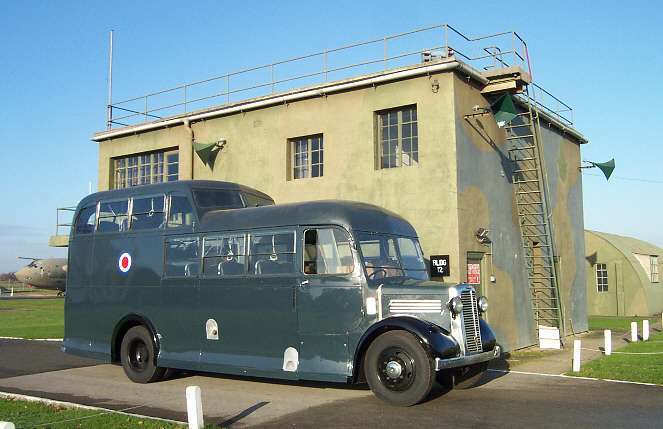
XAT 368 was delivered to the RAF (as RAF 138076) in April 1947 and served at various Yorkshire airfields,
before being sold at Ruddington in October 1957. New owners Hull Cricket Club found it slow, causing the team to frequently arrive late
for matches, although it was good for holding kit! However, a new gearbox cured this problem, but after two years, it was sold on to
Newall Engineering, as a staff bus. It then passed to two commercial operators, Primrose Valley Garage and Coaches and W and H Lamb.
Possibly due to the fact that it only had 20 seats, it proved uneconomical as a coach and was only in such service for seven months. It
seems to have been mothballed before being sold to the British Auto Racing Club in June 1962 for use as a race control vehicle. This saw
the removal of many of the seats and reconfiguration as a mobile office, with desks and tables. Sadly the bus fell into disrepair and
was last driven at Silverstone in 1972, laying in decay until being bought by David Hardcastle in 1978. Despite David's intentions to
restore the vehicle, it remained in this state until he donated it to the RAFBF and the team at RAF Cottesmore in October 1993.
- RAF 137814, New 3/46, c/n 17A0006, b/n B31392
- RAF 137822, New 3/46, c/n 17A0008, b/n B31395
- RAF 137827, New 3/46, c/n 17A0009, b/n B31400
- RAF 137832, New 3/46, c/n 17A0010, b/n B31401
- RAF 137823, New 3/46, c/n 17A0011, b/n B31396
- RAF 137824, New 3/46, c/n 17A0012, b/n B31397
- RAF 137826, New 3/46, c/n 17A0013, b/n B31399
- RAF 137825, New 3/46, c/n 17A0014, b/n B31398
- RAF 137833, New 3/46, c/n 17A0015, b/n B31401
- RAF 137834, New 4/46, c/n 17A0016, b/n B31403
- RAF 137835, New 4/46, c/n 17A0017, b/n B31404
- RAF 137848, New 4/46, c/n 17A0023, b/n B31410
- RAF 137852, New 4/46, c/n 17A0024, b/n B31413
- RAF 137850, New 4/46, c/n 17A0025, b/n B31412
- RAF 137849, New 4/46, c/n 17A0026, b/n B31411
- RAF 137851, New 4/46, c/n 17A0027, b/n B31414
- RAF 137853, New 4/46, c/n 17A0028, b/n B31415
- RAF 137854, New 4/46, c/n 17A0029, b/n B31416
- RAF 137855, New 4/46, c/n 17A0030, b/n B31417
- RAF 137856, New 4/46, c/n 17A0031, b/n B31418
- RAF 137908, New 5/46, c/n 17A0032, b/n B31419
- RAF 137901, New 5/46, c/n 17A0038, b/n B31425
- RAF 137900, New 5/46, c/n 17A0039, b/n B31426
- RAF 137918, New 5/46, c/n 17A0040, b/n B31427
- RAF 137919, New 5/46, c/n 17A0041, b/n B31428
- RAF 137920, New 5/46, c/n 17A0042, b/n B31429
- RAF 137925, New 6/46, c/n 17A0043, b/n B31434
- RAF 137923, New 6/46, c/n 17A0044, b/n B31432
- RAF 137921, New 5/46, c/n 17A0046, b/n B31430
- RAF 137922, New 6/46, c/n 17A0048, b/n B31431
- RAF 137924, New 6/46, c/n 17A0050, b/n B31433
- RAF 137937, New 7/46, c/n 17A0051, b/n B31444
- Reg unknown, New 7/46, c/n 17A0053, b/n B31448
- RAF 137938, New 6/46, c/n 17A0054, b/n B31440
- RAF 137943, New 7/46, c/n 17A0057, b/n B31442
- RAF 137939, New 6/46, c/n 17A0058, b/n B31441
- RAF 137936, New 7/46, c/n 17A0059, b/n B31443
- RAF 137944, New 7/46, c/n 17A0060, b/n B31445
- RAF 137945, New 7/46, c/n 17A0061, b/n B31446
- RAF 121814, New 7/46, c/n 17A0062, b/n B31449
- RAF 137946, New 7/46, c/n 17A0063, b/n B31447
- Reg unknown, New 9/46, c/n 17A0064, b/n B31475
- RAF 121942, New 8/46, c/n 17A0069, b/n B31462
- RAF 122102, New 8/46, c/n 17A0070, b/n B31460
- RAF 122095, New 9/46, c/n 17A0071, b/n B31476
- RAF 122096, New 9/46, c/n 17A0072, b/n B31477
- RAF 138017, New 9/46, c/n 17A0073, b/n B31478
- RAF 121940, New 9/46, c/n 17A0074, b/n B31479
- RAF 122101, New 8/46, c/n 17A0076, b/n B31461
- RAF 121941, New 8/46, c/n 17A0077, b/n B31463
- Reg unknown, New 8/46, c/n 17A0078, b/n B31464
- RAF 122128, New 10/46, c/n 17A0090, b/n B31485
- RAF 17024, New 10/46, c/n 17A0092, b/n B31488
- RAF 137995, New 10/46, c/n 17A0097, b/n B31491
- RAF 137996, New 10/46, c/n 17A0099, b/n B31494
- RAF 137997, New 10/46, c/n 17A0104, b/n B31497
- RAF 137998, New 11/46, c/n 17A0105, b/n B31500
- RAF 137999, New 11/46, c/n 17A0108, b/n B31503
- RAF 122420, New 11/46, c/n 17A0112, b/n B31509
- RAF 138000, New 11/46, c/n 17A0113, b/n B31506
- Reg unknown, New 12/46, c/n 17A0114, b/n B31521
- RAF 122485, New 12/46, c/n 17A0118, b/n B31512
- RAF 138003, New 12/46, c/n 17A0122, b/n B31515
- RAF 138004, New 12/46, c/n 17A0125, b/n B31518
- RAF 138006, New 1/47, c/n 17A0142, b/n B31524
- RAF 138011, New 1/47, c/n 17A0146, b/n B31527
- Reg unknown, New 1/47, c/n 17A0149, b/n B31530
- RAF 138010, New 1/47, c/n 17A0153, b/n B31536
- Reg unknown, New 1/47, c/n 17A0155, b/n B31533
- RAF 138007, New 1/47, c/n 17A0157, b/n B31539
- Reg unknown, New 2/47, c/n 17A0158, b/n B31542
- RAF 138072, New 4/47, c/n 17A0159, b/n B31566
- RAF 122413, New 3/47, c/n 17A0162, b/n B31554
- RAF 138074, New 4/47, c/n 17A0167, b/n B31572
- RAF 138066, New 2/47, c/n 17A0171, b/n B31548
- RAF 122414, New 3/47, c/n 17A0173, b/n B31563
- RAF 138065, New 2/47, c/n 17A0175, b/n B31545
- RAF 122361, New 2/47, c/n 17A0178, b/n B31551
- RAF 138073, New 4/47, c/n 17A0180, b/n B31569
- RAF 122412, New 3/47, c/n 17A0183, b/n B31557
- RAF 122360, New 3/47, c/n 17A0186, b/n B31560
- RAF 138075, New 4/47, c/n 17A0192, b/n B31575
- RAF 138076, New 4/47, c/n 17A0196, b/n B31578, later registered 08 AC 67 and XAT 368, now preserved (see above)
- RAF 138077, New 4/47, c/n 17A0197, b/n B31581
- RAF 138080, New 5/47, c/n 17A0200, b/n B31590
- RAF 138078, New 5/47, c/n 17A0204, b/n B31584
- RAF 138079, New 5/47, c/n 17A0205, b/n B31587
- RAF 138082, New 5/47, c/n 17A0208, b/n B31592
- RAF 138081, New 5/47, c/n 17A0210, b/n B31594
- RAF 138083, New 5/47, c/n 17A0212, b/n B31596
- RAF 138080, New 5/47, c/n 17A0218, b/n B31598
- RAF 138236, New 5/47, c/n 17A0219, b/n B31599
BRITISH EUROPEAN AIRWAYS - total 44.
- Reg unknown, New 10/46, c/n 17A0067, b/n B31482, Based in Vienna
- SME 522, New 11/46, c/n 17A0116, b/n B31510, f/n 1004
- Reg unknown, New 11/46, c/n 17A0117, b/n B31511, f/n 1067
- SME 528, New 12/46, c/n 17A0124, b/n B31517, f/n 1010
- SME 521, New 2/47, c/n 17A0150, b/n B31537, f/n 1003
- SME 529, New 1/47, c/n 17A0154, b/n B31532, f/n 1011
- SME 527, New 2/47, c/n 17A0156, b/n B31538, f/n 1009
- SME 526, New 4/47, c/n 17A0168, b/n B31571, f/n 1008, later converted using parts from a Commer 4x4 truck, owned by Rawsthorn, Bournemouth. Survivor
- SME 530, New 2/47, c/n 17A0169, b/n B31547, f/n 1012
- SME 524, New 4/47, c/n 17A0179, b/n B31568, f/n 1006
- SME 547, New 4/47, c/n 17A0181, b/n B31570, f/n 1013
- SME 546, New 3/47, c/n 17A0182, b/n B31555, f/n 1025
- SME 549, New 3/47, c/n 17A0184, b/n B31556, f/n 1017
- SME 539, New 3/47, c/n 17A0185, b/n B31558, f/n 1020
- SME 538, New 4/47, c/n 17A0187, b/n B31561, f/n 1038
- SME 537, New 3/47, c/n 17A0189, b/n B31559, f/n 1019
- SME 536, New 3/47, c/n 17A0190, b/n B31562, f/n 1039
- SME 541, New 4/47, c/n 17A0194, b/n B31579, f/n 1021
- SME 543, New 4/47, c/n 17A0195, b/n B31576, f/n 1023
- SME 542, New 4/47, c/n 17A0198, b/n B31577, f/n 1022
- SME 540, New 4/47, c/n 17A0199, b/n B31580, f/n 1035
- SME 545, New 5/47, c/n 17A0202, b/n B31582, f/n 1040
- SME 535, New 4/47, c/n 17A0203, b/n B31583, f/n 1018
- SME 523, New 5/47, c/n 17A0206, b/n B31585, f/n 1005
- SME 340, New 5/47, c/n 17A0207, b/n B31591, f/n 1001
- SME 532, New 5/47, c/n 17A0211, b/n B31595, f/n 1033
- SME 533, New 5/47, c/n 17A0213, b/n B31597, f/n 1034
- SME 531, New 6/47, c/n 17A0216, b/n B31609, f/n 1013
- SME 534, New 6/47, c/n 17A0217, b/n B31608, f/n 1041
- SME 341, New 6/47, c/n 17A0224, b/n B31610, f/n 1002
- SME 525, New 6/47, c/n 17A0225, b/n B31611, f/n 1007
- SME 544, New 6/47, c/n 17A0226, b/n B31612, f/n 1024, sold to Hunt (dealer), Iver. Sold to new age travellers. To Milsom 12/03 for restoration. Preserved, survivor
- SME 550, New 6/47, c/n 17A0227, b/n B31613, f/n 1036
- SME 551, New 6/47, c/n 17A0228, b/n B31614, f/n 1037
- SME 552, New 6/47, c/n 17A0229, b/n B31615, f/n 1069
- SME 548, New 6/47, c/n 17A0230, b/n B31616, f/n 1014
- TMG 251, New 6/47, c/n 17A0231, b/n B31618, f/n 1068
- SME 555, New 7/47, c/n 17A0238, b/n B31624, f/n 1044
- SME 556, New 7/47, c/n 17A0239, b/n B31625, f/n 1045
- SME 557, New 7/47, c/n 17A0241, b/n B31629, f/n 1054
- SME 558, New 7/47, c/n 17A0243, b/n B31630, f/n 1046
- SME 559, New 7/47, c/n 17A0246, b/n B31631, f/n 1047
- SME 560, New 7/47, c/n 17A0248, b/n B31632, f/n 1048
- SME 554, New 7/47, c/n 17A0252, b/n B31638, f/n 1043
BRITISH OVERSEAS AIRWAYS CORPORATION - total 115.
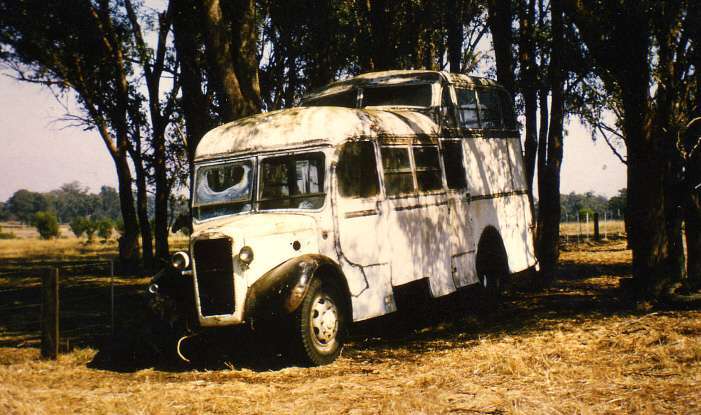
LS-271 under the trees on the Zegir farm in use as a store room.
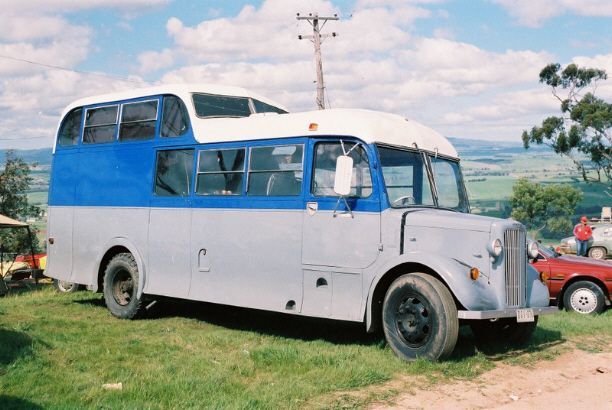
Mike Cornwall sent the picture above. He took it in Bathurst (NSW) in 1988, which was the first year that
the bus was there.
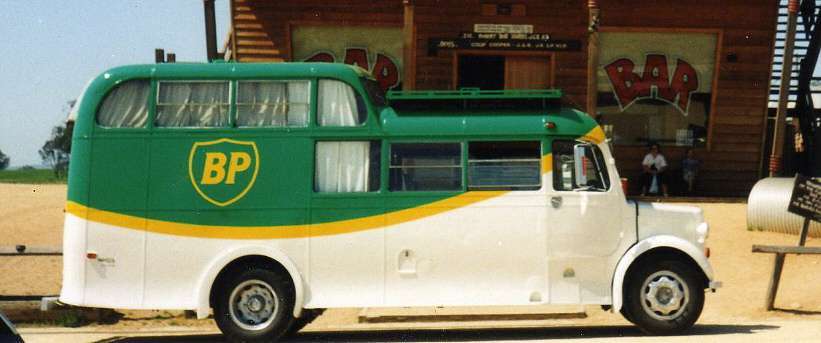
And a side view of LS-271 in its BP livery.
Six of these buses served with BOAC in Australia, they were later sold to Australia National Airways.
One of them survives with local rego LS-271 in the town of Seymour in Victoria. After a spell with St. John Ambulance in the early 1970s,
it was sold to the Zegir family to become a camper in 1976, but then became a storage unit on a farm from 1979. Peter Sanderson bought
it in 1988 and restored it, replacing the original petrol engine with a Chrysler V8 dual fuel unit and automatic transmission, plus
painting it in BP colours. It makes an annual trip to the Bathurst 1000, a 1000 km car race on public mountain roads. Unfortunately no
chassis or body number has yet been discovered, so its unclear exactly which one of the 61 unknown reg BOAC vehicles it is, or what the
other five were. This sad looking example is
probably one of the others, seen in Queensland in 2015. Obviously it had been there a long time......
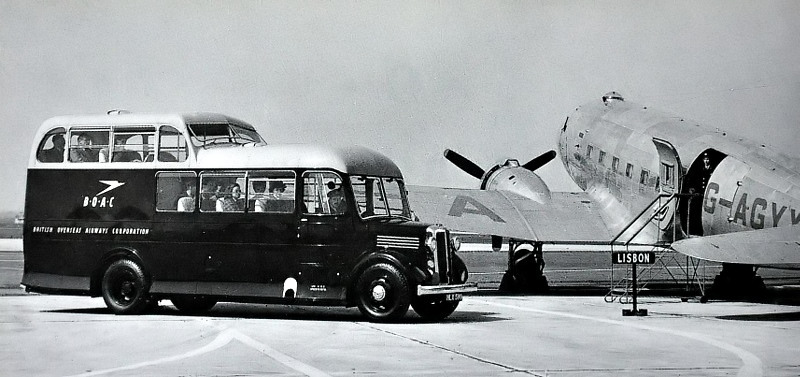
The picture above shows one of the BOAC buses, probably at Northolt, appearing to deliver passengers to
a Dakota aircraft bound for Lisbon. Its likely that this was a "staged" publicity photo, as BOAC was a long-haul airline and didn't
operate flights to Lisbon. The bus is HLX 599, the second of these Commandos to be built and the first one delivered to BOAC (in March
1946), so that may be what this is all about.
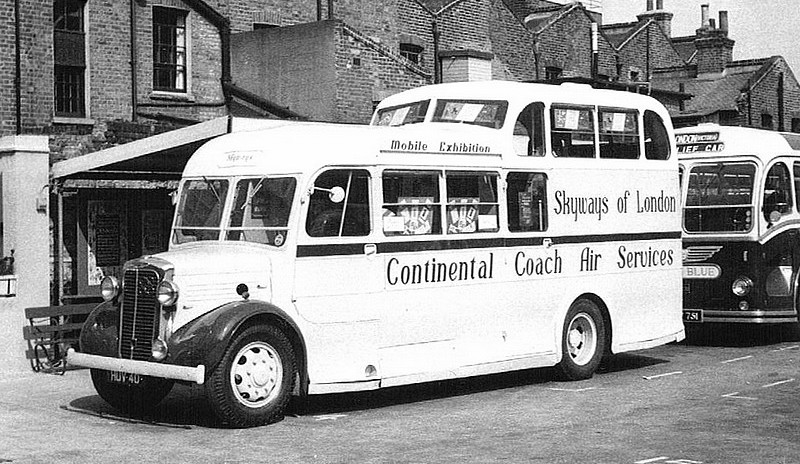
This picture shows another BOAC coach (HUV 40 dating from June 1946) after sale to Skyways who were
using it to promote their new coach-air service which ran East Kent AEC Reliances from Victoria Coach Station (where this photo was
taken in the late 1950s) down to Lympne Airport in Kent where a Skyways Dakota would fly the passengers to France. By coincidence one of
the Dakotas that Skyways used for a while was none other than G-AGYX - the same one as shown in the previous picture.
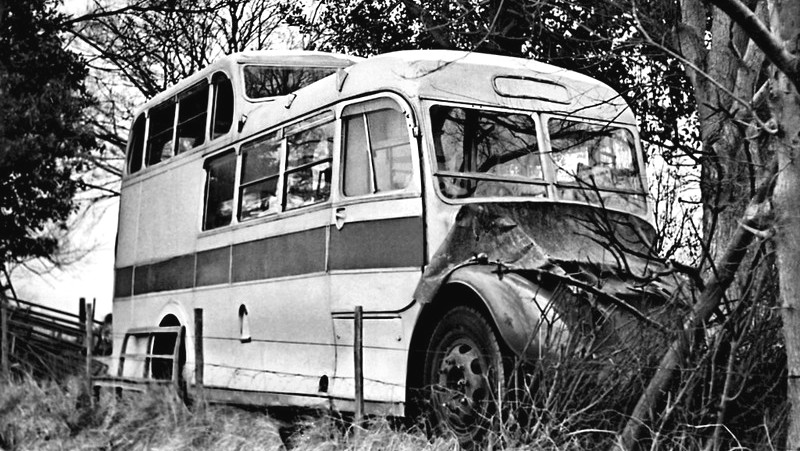
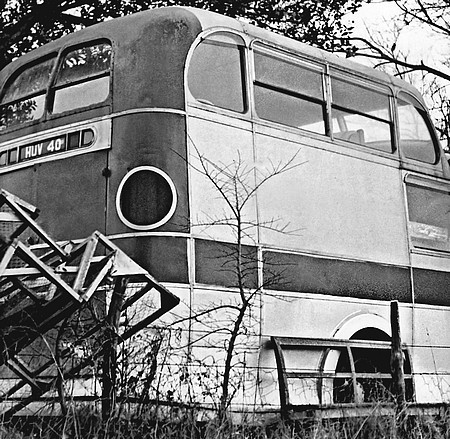
By the early 1960s Skyways had finished with HUV 40 and its fate was unknown to Dick Gilbert, until
Chris Stanley very kindly sent these two pictures which he acquired from someone who, in turn, got them from a deceased friend. It's
clearly the same coach and is apparently rotting away in a field in Sellinge, which is within spitting distance of Lympne Airport, so
that makes sense. Dick was a Skyways employee at Lympne from 1965 to 1969 but never knew that the coach existed nearby. By the look of
the paintwork it had clearly had another owner since Skyways days - perhaps as a mobile home - and someone has removed the engine. It
was originally a 6-cylinder 4-litre petrol engine, but the picture at Victoria Coach Station shows it with a Perkins diesel badge on the
radiator grille. However it didn't look to be in a bad condition overall.
- HLX 599, New 3/46, c/n 17A0007, b/n B31394
- 9177 CB 4, New 10/46, c/n 17A0018, b/n B31405, based in Marseilles
- 8771, New 7/46, c/n 17A0019, b/n B31406, based in Malta
- Reg unknown, New 4/46, c/n 17A0020, b/n B31407
- Reg unknown, New 4/46, c/n 17A0021, b/n B31408
- Reg unknown, New 4/46, c/n 17A0022, b/n B31409
- HUC 447, New 5/46, c/n 17A0033, b/n B31420
- HUL 791, New 5/46, c/n 17A0034, b/n B31421
- HUL 987, New 5/46, c/n 17A0035, b/n B31422
- HUL 986, New 5/46, c/n 17A0036, b/n B31423
- HUL 988, New 5/46, c/n 17A0037, b/n B31424
- HUV 40, New 6/46, c/n 17A0045, b/n B31439, sold to Skyways mid to late 1950s, derelict near Lympne Airport in Kent early 1960s
- HUV 136, New 6/46, c/n 17A0047, b/n B31437
- HUU 979, New 6/46, c/n 17A0049, b/n B31435
- HUU 980, New 6/46, c/n 17A0052, b/n B31436
- HUV 135, New 6/46, c/n 17A0055, b/n B31438
- Reg unknown, New 3/46, c/n 17A0056, b/n B31393
- HXB 81, New 7/46, c/n 17A0065, b/n B31450
- TI 3967, New 10/46, c/n 17A0066, b/n B31481, based in Shannon
- Reg unknown, New 10/46, c/n 17A0068, b/n B31483, based in Hamburg
- HXF 339, New 7/46, c/n 17A0075, b/n B31480
- HUW 282, New 8/46, c/n 17A0079, b/n B31465
- Reg unknown, New 8/46, c/n 17A0080, b/n B31466
- HUW 283, New 8/46, c/n 17A0081, b/n B31467
- HXA 33, New 9/46, c/n 17A0082, b/n B31472
- HUW 492, New 9/46, c/n 17A0083, b/n B31468
- HUW 493, New 9/46, c/n 17A0084, b/n B31469
- HUW 698, New 9/46, c/n 17A0085, b/n B31470
- HXW 244, New 9/46, c/n 17A0086, b/n B31473, based at Stornoway airport, sold to Kennedy, Stornoway 1951, sold for use as a mobile shop on the Isle of Lewis in 1958. Later converted into a mess room for a builder's firm and lastly ended up as a 'shieling' for peat cutters at Cuidhsiader in the late 1970s. Gone sometime between 2013 and 2021. See here for views of it in its last years.
- HUW 697, New 9/46, c/n 17A0087, b/n B31471
- Reg unknown, New 10/46, c/n 17A0088, b/n B31484, based in Athens
- Reg unknown, New 9/46, c/n 17A0089, b/n B31474
- HXW 952, New 10/46, c/n 17A0091, b/n B31486
- HXX 33, New 10/46, c/n 17A0093, b/n B31489
- Reg unknown, New 10/46, c/n 17A0094, b/n B31487
- Reg unknown, New 10/46, c/n 17A0095, b/n B31490
- Reg unknown, New 10/46, c/n 17A0096, b/n B31492
- Reg unknown, New 10/46, c/n 17A0098, b/n B31493
- 5530 CB 5, New 10/46, c/n 17A0100, b/n B31495, based in Marseilles
- Reg unknown, New 11/46, c/n 17A0101, b/n B31499
- Reg unknown, New 10/46, c/n 17A0102, b/n B31496
- Reg unknown, New 11/46, c/n 17A0103, b/n B31498
- 7169, New 2/47, c/n 17A0106, b/n B31502, based in Malta
- Reg unknown, New 11/46, c/n 17A0107, b/n B31501
- CY 962, New 12/46, c/n 17A0109, b/n B31504, based in Columbo
- Reg unknown, New 11/46, c/n 17A0110, b/n B31505
- HYE 143, New 11/46, c/n 17A0111, b/n B31507
- HYE 142, New 11/46, c/n 17A0115, b/n B31508
- HXP 492, New 12/46, c/n 17A0119, b/n B31522
- CV 1098, New 12/46, c/n 17A0120, b/n B31513, based in Columbo
- Reg unknown, New 12/46, c/n 17A0121, b/n B31514
- HXP 491, New 12/46, c/n 17A0123, b/n B31516
- Reg unknown, New 12/46, c/n 17A0126, b/n B31451
- Reg unknown, New 7/46, c/n 17A0127, b/n B31452
- Reg unknown, New 7/46, c/n 17A0128, b/n B31455
- Reg unknown, New 7/46, c/n 17A0129, b/n B31454
- Reg unknown, New 7/46, c/n 17A0130, b/n B31456
- IST 3195, New 8/46, c/n 17A0131, b/n B31457, based in Istanbul
- Reg unknown, New 8/46, c/n 17A0132, b/n B31453
- Reg unknown, New 1/47, c/n 17A0133, b/n B31459, based in Berlin
- Reg unknown, New 8/46, c/n 17A0134, b/n B31458, based in Hamburg
- Reg unknown, New 8/46, c/n 17A0135, b/n B31573
- Reg unknown, New 4/47, c/n 17A0136, b/n B31600
- Reg unknown, New 5/47, c/n 17A0137, b/n B31574
- Reg unknown, New 4/47, c/n 17A0138, b/n B31601
- Reg unknown, New 5/47, c/n 17A0139, b/n B31519
- HYF 437, New 5/47, c/n 17A0140, b/n B31523
- HYF 436, New 5/47, c/n 17A0141, b/n B31520
- Reg unknown, New 1/47, c/n 17A0143, b/n B31529
- Reg unknown, New 1/47, c/n 17A0144, b/n B31525
- Reg unknown, New 1/47, c/n 17A0145, b/n B31526
- Reg unknown, New 1/47, c/n 17A0147, b/n B31528, based in Athens
- HYO 276, New 2/47, c/n 17A0148, b/n B31531
- Reg unknown, New 1/47, c/n 17A0151, b/n B31534
- Reg unknown, New 1/47, c/n 17A0152, b/n B31535
- Reg unknown, New 2/47, c/n 17A0160, b/n B31540
- Reg unknown, New 2/47, c/n 17A0161, b/n B31550
- Reg unknown, New 2/47, c/n 17A0163, b/n B31541
- Reg unknown, New 2/47, c/n 17A0164, b/n B31546
- Reg unknown, New 3/47, c/n 17A0165, b/n B31553
- Reg unknown, New 2/47, c/n 17A0166, b/n B31543
- Reg unknown, New 2/47, c/n 17A0170, b/n B31544
- Reg unknown, New 4/47, c/n 17A0172, b/n B31565
- Reg unknown, New 4/47, c/n 17A0174, b/n B31567
- HYO 275, New 2/47, c/n 17A0176, b/n B31549
- Reg unknown, New 2/47, c/n 17A0177, b/n B31552
- Reg unknown, New 4/47, c/n 17A0188, b/n B31564
- Reg unknown, New 5/47, c/n 17A0191, b/n B31588
- Reg unknown, New 5/47, c/n 17A0193, b/n B31589
- HYO 274, New 5/47, c/n 17A0201, b/n B31586
- HYO 269, New 5/47, c/n 17A0209, b/n B31593
- HYO 270, New 6/47, c/n 17A0214, b/n B31607
- Reg unknown, New 6/47, c/n 17A0215, b/n B31606
- Reg unknown, New 6/47, c/n 17A0220, b/n B31603
- Reg unknown, New 6/47, c/n 17A0221, b/n B31605
- Reg unknown, New 6/47, c/n 17A0222, b/n B31604
- Reg unknown, New 6/47, c/n 17A0223, b/n B31602
- Reg unknown, New 6/47, c/n 17A0232, b/n B31619
- Reg unknown, New 6/47, c/n 17A0233, b/n B31617
- Reg unknown, New 6/47, c/n 17A0234, b/n B31620
- Reg unknown, New 6/47, c/n 17A0235, b/n B31621
- Reg unknown, New 7/47, c/n 17A0236, b/n B31623
- Reg unknown, New 7/47, c/n 17A0237, b/n B31622
- Reg unknown, New 7/47, c/n 17A0240, b/n B31626
- Reg unknown, New 7/47, c/n 17A0242, b/n B31628
- Reg unknown, New 7/47, c/n 17A0244, b/n B31627
- Reg unknown, New 7/47, c/n 17A0245, b/n B31634
- HYP 694, New 7/47, c/n 17A0247, b/n B31633
- HYP 691, New 7/47, c/n 17A0249, b/n B31636
- HYP 692, New 7/47, c/n 17A0250, b/n B31635
- HYP 693, New 7/47, c/n 17A0251, b/n B31637
- HYP 696, New 8/47, c/n 17A0253, b/n B31639 Used for parts in the restoration of XAT 368
- HYP 697, New 8/47, c/n 17A0254, b/n B31641
- Reg unknown, New 8/47, c/n 17A0255, b/n B31640
- HYP 695, New 8/47, c/n 17A0256, b/n B31642
MINISTRY of SUPPLY - total 64.
- HYT 147, New 8/47, c/n 17A0257, b/n B31643
- HYT 135, New 8/47, c/n 17A0258, b/n B31644
- HYT 233, New 8/47, c/n 17A0259, b/n B31645
- HYT 230, New 8/47, c/n 17A0260, b/n B31646
- HYT 235, New 8/47, c/n 17A0261, b/n B31647
- HYT 232, New 9/47, c/n 17A0262, b/n B31648
- HYT 301, New 9/47, c/n 17A0263, b/n B31649
- HYT 302, New 9/47, c/n 17A0264, b/n B31650
- HYT 366, New 9/47, c/n 17A0265, b/n B31651
- HYT 406, New 9/47, c/n 17A0266, b/n B31653
- HYT 405, New 9/47, c/n 17A0267, b/n B31654
- HYT 373, New 9/47, c/n 17A0268, b/n B31652
- Reg unknown, New 9/47, c/n 17A0269, b/n B31655
- HYT 503, New 9/47, c/n 17A0270, b/n B31656
- HYT 598, New 10/47, c/n 17A0271, b/n B31659, exported to Canada for motor home conversion 1950s, still exists in storage 2024
- HYT 614, New 10/47, c/n 17A0272, b/n B31660
- HYT 526, New 9/47, c/n 17A0273, b/n B31657
- HYT 525, New 9/47, c/n 17A0274, b/n B31658
- HYT 685, New 10/47, c/n 17A0275, b/n B31663
- HYT 680, New 10/47, c/n 17A0276, b/n B31661
- HYT 714, New 10/47, c/n 17A0277, b/n B31664
- HYT 640, New 10/47, c/n 17A0278, b/n B31662
- HYT 713, New 10/47, c/n 17A0279, b/n B31665
- HYT 745, New 10/47, c/n 17A0280, b/n B32044
- HYT 753, New 10/47, c/n 17A0281, b/n B32045
- HYT 279, New 10/47, c/n 17A0282, b/n B31666
- HYT 752, New 10/47, c/n 17A0283, b/n B32046
- HYT 804, New 11/47, c/n 17A0284, b/n B32047
- HYT 779, New 10/47, c/n 17A0285, b/n B32048
- HYT 802, New 11/47, c/n 17A0286, b/n B32049
- HYT 894, New 11/47, c/n 17A0287, b/n B32052
- HYT 803, New 11/47, c/n 17A0288, b/n B32050
- HYT 893, New 11/47, c/n 17A0289, b/n B32051
- HYT 867, New 11/47, c/n 17A0290, b/n B32053
- HYT 868, New 11/47, c/n 17A0291, b/n B32054
- HYT 933, New 11/47, c/n 17A0292, b/n B32056
- HYT 934, New 11/47, c/n 17A0293, b/n B32055
- Reg unknown, New 11/47, c/n 17A0294, b/n B32062
- HYT 998, New 11/47, c/n 17A0295, b/n B32059
- JLR 56, New 12/47, c/n 17A0296, b/n B32063
- HYT 988, New 11/47, c/n 17A0297, b/n B32058
- HYT 999, New 11/47, c/n 17A0298, b/n B32060
- HYT 935, New 11/47, c/n 17A0299, b/n B32057
- JLR 138, New 12/47, c/n 17A0300, b/n B32066 Preserved
- JLR 78, New 12/47, c/n 17A0301, b/n B32064
- JLR 29, New 11/47, c/n 17A0302, b/n B32061
- JLR 152, New 12/47, c/n 17A0303, b/n B32067
- JLR 137, New 12/47, c/n 17A0304, b/n B32065
- JLR 210, New 12/47, c/n 17A0305, b/n B32070
- Reg unknown, New 1/48, c/n 17A0306, b/n B32076
- JLR 150, New 12/47, c/n 17A0307, b/n B32068
- JLR 208, New 12/47, c/n 17A0308, b/n B32071
- JLR 209, New 12/47, c/n 17A0309, b/n B32069
- JLR 245, New 12/47, c/n 17A0310, b/n B32073
- JLR 221, New 12/47, c/n 17A0311, b/n B32072
- JLR 222, New 12/47, c/n 17A0312, b/n B32074
- Reg unknown, New 1/48, c/n 17A0313, b/n B32083
- JLR 246, New 1/48, c/n 17A0314, b/n B32075
- Reg unknown, New 1/48, c/n 17A0315, b/n B32079
- Reg unknown, New 1/48, c/n 17A0316, b/n B32078
- Reg unknown, New 1/48, c/n 17A0317, b/n B32077
- Reg unknown, New 1/48, c/n 17A0318, b/n B32082
- Reg unknown, New 1/48, c/n 17A0319, b/n B32080
- JLR 475, New 1/48, c/n 17A0320, b/n B32081
Notes: A photo exists of one bus registered TJ 72731 at Johannesburg airport, while another photo shows
two (or maybe three) of them at the same airport. Presumably sold by BOAC to South African Airways, but individual vehicle identities
are unknown. Another photo depicts a BEA one in Berlin with the reg 2833 BZ, but this is not a German plate, so maybe the caption is
wrong? One was known to be with Short Brothers in Belfast, a poor quality shot suggests the reg was HYT 813.
Another one was (possibly) at Rush Green Motors (see
UTM 752) with a large tree growing though it. That reg does not appear in the lists above, so it may be a former RAF example with a
civilian reg number.The two examples working in Malta required special approval to enter Valetta Bus Station due to their double deck
configuration. Survivors in 2024 include one in British Columbia (originally HYT 598), four in Britain and one or two in Australia.
John Humphrey writes: "Just been looking at the Commer Commando article and I have been reminded that,
when on holiday with my parents in Weymouth in 1959, we took a day trip to St. Peter Port (Guernsey). Just before boarding the ship for
the return crossing, I noticed one of these vehicles in BEA livery parked opposite the bus station and I am pretty sure that it had been
re-registered with a local registration. Sorry I don't remember any more, but I thought this would still be worth sharing with you".
Thanks John.
This sad looking example
is probably one of the six that went to Australia, where it was seen in Queensland in 2015. Obviously it had been there a long time......
A book from 2010 (Sri Lankan Buses Past and Present) includes a photo of one of the Commers with the
registration 33-Sri-4093, thought to be an ex RAF vehicle which was exported during the late 1950s or early 1960s. Again its original
identity is unclear as of now. If anyone can help with the above queries, or provide further information, please contact me.
Apart from the half dozen (or seven??) full size survivors, the type has also been produced in 1:76 scale
by Oxford Diecast, in no less than eight versions, as below:
XAT 368 in RAF livery, real vehicle is preserved
HXF 339 in BOAC livery
TMG 114 in BEA livery (reg not in vehicle lists above)
NYP 635 in Billy Smarts Circus livery (reg not in vehicle lists above)
LS-271 in Australia National Airways livery, real vehicle preserved in BP livery in Australia
TJ 72731 in South African Airways livery
HUV 40 in Skyways livery
CC 1947 in Coca Cola livery possibly fictional reg and livery?
SOME LINKS WITHIN THIS WEBSITE:
Home
Email
Links
THE COMPLETE WEBSITE MENU
Events Diary
Halfcab list
Small-Ads
Classic Irish Buses
Classic Manx Buses
SB









